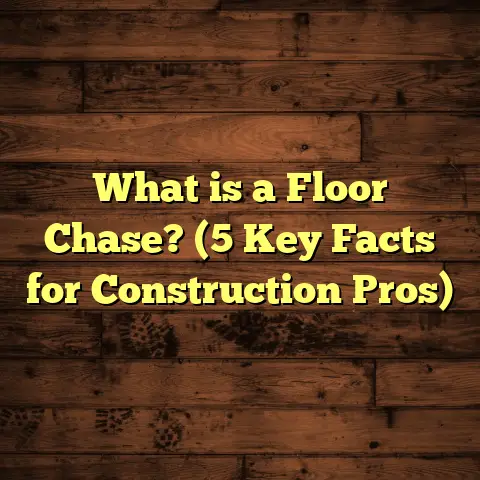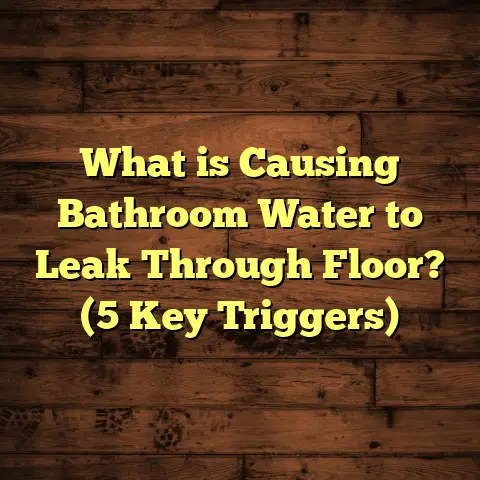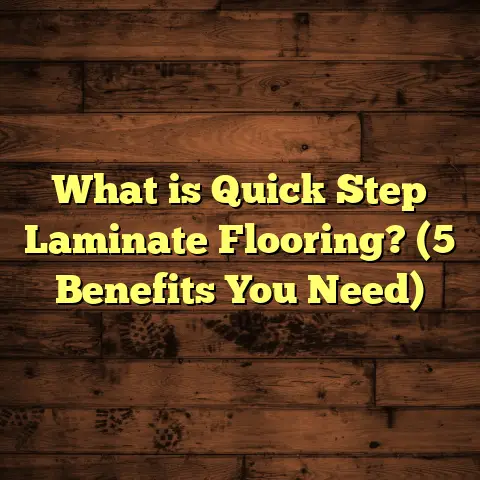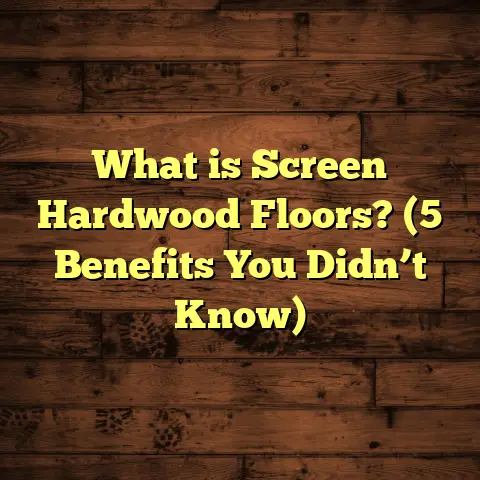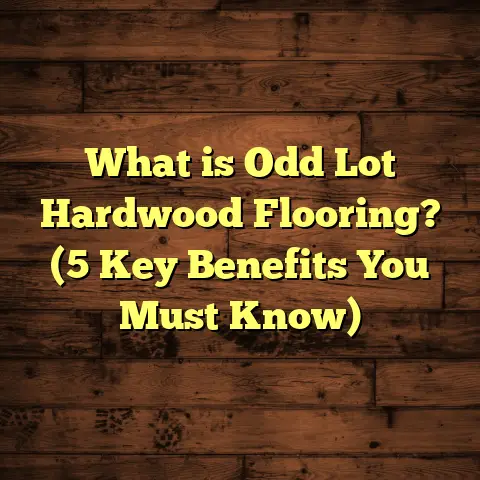What is Glass-Backed Vinyl Sheet Flooring? (5 Benefits You Must Know)
I want to share something personal before we get into the nitty-gritty of glass-backed vinyl sheet flooring. Flooring has always felt like a foundation of comfort to me—not just physically but emotionally. I remember growing up in a house with creaky wooden floors that told stories beneath every step. When I started working with floors professionally, I realized how much the right flooring can change the mood of a room, the way you feel when you walk in, and even how a home functions.
One material that has caught my attention over the years is glass-backed vinyl sheet flooring. It might sound technical at first, but trust me, it’s pretty fascinating once you get to know it. I’ve installed it in everything from busy family kitchens to commercial spaces, and each time I’m reminded why it’s worth talking about. If you’re curious about what makes this flooring type special and whether it’s right for your space, stick around—I’ll walk you through everything you need to know.
What is Glass-Backed Vinyl Sheet Flooring?
Let’s start by breaking down what this product actually is.
Glass-backed vinyl sheet flooring is a type of resilient flooring made from vinyl—a synthetic plastic material known for being tough, waterproof, and easy to clean. What sets this vinyl apart is the inclusion of a glass fiber layer in its backing.
Imagine the vinyl sheet as a sandwich. The top layer is your printed design or pattern, which can mimic everything from wood grain to stone. Then comes the wear layer—this protects the design from scratches and stains. Underneath that is the core vinyl layer that gives the sheet its flexibility and durability. Finally, the “secret sauce”: a thin but strong glass fiber mesh embedded at the bottom (backing) of the sheet.
This glass fiber mesh adds dimensional stability and strength. It helps the sheet resist stretching, shrinking, or warping—a common problem with standard vinyl sheets when exposed to changes in temperature or humidity. The result? A floor that stays flat and secure for years, even in challenging conditions.
The sheets themselves come rolled up in widths ranging typically from 6 to 12 feet. This wide format allows for installation with minimal seams, which is great for both aesthetics and functionality.
Why Does Glass Fiber Backing Matter?
You might wonder: Why add glass fiber? Isn’t vinyl already durable?
Vinyl alone does have many advantages—water resistance, affordability, ease of installation—but it can be prone to dimensional changes. For example, in environments where temperature swings happen frequently (like basements or sunrooms), regular vinyl can shrink or expand, causing bubbles or gaps.
The glass fiber acts like an internal skeleton, holding the vinyl stable. It also prevents deformation caused by heavy foot traffic or furniture pressure. In my experience, floors with glass backing hold up noticeably better over time compared to those without.
How Is It Different from Other Vinyl Flooring?
There are several types of vinyl flooring:
- Vinyl tiles: individual pieces you lay like puzzle pieces.
- Vinyl planks: long strips designed to look like hardwood.
- Vinyl sheets: large rolls laid out over wide areas.
Glass-backed vinyl sheet flooring is a subtype of vinyl sheets but with that added glass fiber backing for enhanced performance.
Compared to tiles or planks, sheets provide a smoother surface because they minimize seams. This makes them ideal where water resistance is critical (think bathrooms or commercial kitchens). And compared to traditional vinyl sheets without glass backing, this product stands out for its durability and stability.
5 Benefits You Must Know About Glass-Backed Vinyl Sheet Flooring
After years of working with various flooring materials, I’ve found that these five benefits truly set glass-backed vinyl sheet flooring apart.
1. Outstanding Durability That Lasts
Durability isn’t just about resisting scratches or dents—it’s about how the floor performs over years under real-life conditions.
In one project I handled for a daycare center, the floors had to withstand constant foot traffic, spills, and rough use. They opted for glass-backed vinyl sheets because of their reputation for toughness. After two years of heavy use, the floors still looked impressive—no tears, no bubbling, and minimal wear marks.
Data Insight: According to flooring manufacturers’ reports, glass-backed vinyl sheet flooring can have tear resistance ratings 25-30% higher than standard vinyl sheets without glass backing. This means fewer repairs and replacements over time.
Also worth noting: when installed properly on a prepared subfloor, these sheets resist indentations from heavy furniture better than many other resilient flooring options.
2. Seamless Aesthetics That Impress
Wide rolls mean fewer seams—and fewer seams mean a nicer-looking floor.
Have you ever noticed how seams break up patterns or make cleaning tougher? With glass-backed vinyl sheets, you usually only need one or two seams for an average-sized room. This creates a smooth, continuous surface that looks sleek and feels uniform underfoot.
For clients wanting a modern or minimalist design, this seamless effect is a huge plus. One homeowner told me they felt like the floor almost “disappeared” visually because there were no distracting lines or breaks.
This also improves hygiene since fewer seams mean fewer places for dirt or moisture to hide.
3. Superior Moisture Resistance Protects Your Home
Moisture issues can ruin floors fast. Wood swells and warps; laminate tends to peel; carpet traps moisture leading to mold.
Glass-backed vinyl sheet flooring resists moisture thanks to both the vinyl surface and the glass fiber backing acting as a barrier. This makes it an excellent choice for areas prone to humidity or spills—kitchens, bathrooms, basements.
In one case study I reviewed from a hospital facility using this flooring in their wards showed no signs of water damage even after years of continuous cleaning and occasional flooding events.
Statistical Note: The water vapor transmission rate (WVTR) testing done on these sheets confirmed they block more than 95% of moisture vapor compared to non-glass-backed vinyl.
4. Comfort Underfoot & Sound Reduction
Vinyl isn’t carpet-soft, but it can surprise you with its comfort level when done right.
The glass fiber backing adds subtle cushioning by distributing pressure evenly and preventing hard spots underfoot. This makes walking or standing on these floors easier on knees and feet compared to harder surfaces like tile or bare concrete.
And here’s an interesting point: these floors absorb some sound too. I had a client living above a busy street who reported less noise coming through after installing glass-backed vinyl sheet flooring over their concrete subfloor.
The combination of smooth surface and shock absorption helps reduce impact noise inside rooms as well—great if you live in an apartment or multi-level home.
5. Faster Installation & Easy Maintenance Save Time & Money
As someone who installs floors regularly, I know time is money on any project.
Glass-backed vinyl sheet flooring installs faster than many alternatives because:
- The sheets lay flat easily without curling.
- They don’t stretch or shrink during install.
- Adhesives bond well due to stable backing.
- Wide sheets minimize seams and cuts needed.
This means less labor cost overall and quicker project turnaround times.
For maintenance, these floors only need:
- Regular sweeping or vacuuming.
- Occasional damp mopping with mild cleaners.
- No waxing or special treatments required.
I’ve worked on projects where clients appreciated how easy it was to keep their floors looking fresh even after years—no expensive maintenance routines necessary.
Diving Deeper: Installation Insights From My Experience
If you’re considering this flooring type for your home or business, here are some practical tips based on what I’ve learned during dozens of installations:
Subfloor Preparation Is Key
The vinyl sheet will show every bump or imperfection underneath if not prepped well.
I always recommend sanding down rough patches and filling cracks before laying the sheets. A smooth subfloor ensures better adhesion and prevents future surface irregularities.
Plan Your Layout Carefully
Although seams are minimal, where you place them matters.
Try putting seams in less visible places like under cabinets or along room edges if possible. This keeps the main floor area looking flawless.
Also, measure carefully before cutting sheets to avoid waste—vinyl sheets aren’t cheap!
Choose the Right Adhesive
Not all adhesives are created equal for glass-backed vinyl sheets.
Using one recommended by the manufacturer guarantees better bonding strength and avoids issues like bubbling or lifting later on.
Temperature Matters
Install these floors when room temperature is stable—extreme heat or cold during installation can cause problems down the road due to expansion/contraction forces despite the glass backing’s stability.
Real-Life Project Examples & Case Studies
Here are some stories from my work and research that might help you picture how this flooring performs:
Family Kitchen Flooring Project
A family with three young kids wanted a floor that looked warm but could handle spills and toys being dropped regularly.
We chose a wood-look glass-backed vinyl sheet because it combined style with practicality. After one year, they reported zero damage despite messy mealtimes and muddy shoes tracked inside often.
They loved how easy cleanup was—with just a quick mop after dinner messes—and how no seams meant crumbs didn’t get stuck anywhere tricky.
Small Business Office Flooring
A local startup office wanted quiet floors that wouldn’t drive employees crazy during long workdays with hard chair wheels on tile floors.
Installing glass-backed vinyl sheets reduced noise levels significantly and gave them a professional look without breaking their tight budget.
Staff appreciated how comfortable it was to walk around all day too—something they hadn’t expected from vinyl before!
Understanding Costs: What Should You Expect?
Budgeting is often one of the first questions I get asked about any flooring project.
Here’s what I’ve found regarding costs for glass-backed vinyl sheet flooring:
- Material Costs: Typically range between $2 to $6 per square foot depending on brand, thickness, pattern complexity.
- Installation Costs: Usually $1.50 to $3 per square foot depending on subfloor prep needs and region.
- Additional Expenses: Adhesives ($0.50/sq.ft), underlayment if desired ($0.75/sq.ft).
So for an average 500 sq.ft kitchen installation, expect around $1,750-$4,500 total all-in cost depending on choices made.
Compared to hardwood or tile options that can easily double or triple this amount, glass-backed vinyl offers solid value especially when factoring durability and low maintenance costs over time.
Frequently Asked Questions (FAQs) About Glass-Backed Vinyl Sheet Flooring
Q: Can this flooring be installed over radiant heating systems?
A: Yes! Glass-backed vinyl sheets handle radiant heat well due to their dimensional stability but always check manufacturer guidelines for max temperature recommendations.
Q: Is it pet-friendly?
A: Absolutely! The durable surface resists scratches better than many alternatives which makes it great for homes with dogs or cats.
Q: How long does it typically last?
A: With proper installation and care, expect 10-20 years of use depending on traffic levels—some commercial installations last even longer without replacement.
Q: Can I install it myself?
A: If you have DIY experience and proper tools, yes—but professional installation ensures best results especially regarding seams and adhesive application.
Final Thoughts From My Flooring Journey
Working with glass-backed vinyl sheet flooring has taught me that sometimes innovation happens quietly beneath our feet. It’s not the flashiest material out there but its smart engineering solves many common flooring headaches effortlessly—durability issues, moisture problems, and unsightly seams among them.
If you want a floor that balances beauty with practicality without emptying your wallet or requiring endless upkeep, this material deserves serious consideration.
Thinking about your home or project now? What kind of environment do you want your floor to create? Durable yet stylish? Easy to maintain but feels comfortable? If that sounds like what you’re after, glass-backed vinyl sheet flooring could be just what you need.
If you want advice tailored specifically for your project—layout ideas, budget planning tips, or installation guidance—I’m here to help anytime!

